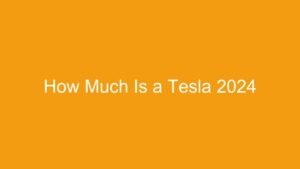
Contents
How Much Is a Tesla New? Your Ultimate Guide to Understanding New Tesla Prices
Dreaming of a brand-new Tesla but wondering how much it will actually set you back? You’re not alone! Many aspiring EV owners ask, “How much is a Tesla new?” The answer isn’t a simple single number, as Tesla’s pricing, like any car, depends on the model, trim, options, and even government incentives.
But don’t worry! This detailed guide will walk you through everything you need to know about new Tesla prices, helping you understand the factors involved and how to get an accurate quote for your dream electric vehicle.
The Short Answer: A Broad Price Range
While there’s no single “new Tesla price,” you can expect the base price for a new Tesla to range from approximately $38,000 to over $100,000, depending heavily on the model you choose and its configuration.
🛒 Recommended Product
- Entry-level models (like the Model 3 and Model Y) typically start at the lower end of this spectrum.
- Luxury and performance models (like the Model S and Model X) command higher prices.
- The Cybertruck also falls into a unique price bracket, generally starting above the entry-level models.
Remember: These are starting Manufacturer’s Suggested Retail Prices (MSRPs) and don’t include options, destination fees, or taxes, which can add thousands to the final cost. Tesla’s pricing can also fluctuate frequently, so what you see today might be slightly different tomorrow.
What Factors Influence a New Tesla’s Price?
Understanding the components that make up the final price is key. Here are the main elements that will impact how much your new Tesla costs:
1. The Tesla Model You Choose
This is the most significant factor. Tesla currently offers several distinct models, each with a different base price:
- Model 3: Often considered Tesla’s most affordable sedan, a great entry point into EV ownership.
- Model Y: A popular compact SUV, offering more utility and space than the Model 3.
- Model S: Tesla’s flagship luxury sedan, known for its performance and premium features.
- Model X: A luxury SUV with unique “falcon wing” doors and seating for up to seven.
- Cybertruck: Tesla’s futuristic all-electric pickup truck, with distinct styling and capabilities.
Each model has a different base MSRP (Manufacturer’s Suggested Retail Price) before any upgrades.
2. Trim Level and Configuration
Within each model, Tesla offers different trim levels, often designated as “Rear-Wheel Drive,” “Long Range,” or “Performance.” These trims typically vary in:
- Battery Size/Range: Longer range usually means a higher price.
- Motor Configuration: Rear-wheel drive (RWD), All-wheel drive (AWD) with dual motors. AWD often costs more.
- Performance: Faster acceleration and higher top speeds come with “Performance” trims, which are the most expensive.
3. Autopilot and Full Self-Driving (FSD) Capability
Tesla’s advanced driver-assistance systems are a major cost consideration:
- Autopilot: This comes standard on all new Teslas and includes features like traffic-aware cruise control and autosteer.
- Enhanced Autopilot (EAP): An optional upgrade that adds features like Navigate on Autopilot, automatic lane changes, autopark, and Summon.
- Full Self-Driving (FSD) Capability: This is Tesla’s most advanced (and most expensive) optional upgrade. It includes all EAP features plus features like Traffic Light and Stop Sign Control and Autosteer on city streets. It’s a substantial additional cost, often thousands of dollars, and can also be purchased as a monthly subscription after delivery.
4. Paint Color, Wheels, and Interior Options
Personalizing your Tesla also adds to the price:
🛒 Recommended Product
- Standard Paint Color: Usually a specific color (e.g., Pearl White Multi-Coat) is included in the base price.
- Premium Paint Colors: Other colors (like Midnight Silver Metallic, Deep Blue Metallic, Solid Black, or Red Multi-Coat) are optional upgrades and can add $1,000-$2,500+.
- Wheel Upgrades: Standard wheels are included, but larger or aerodynamically optimized wheels are optional and can cost $1,500-$2,500+.
- Interior Options: While Tesla often provides a choice of a standard interior color, upgrading to a premium white interior or other options can add $1,000-$2,000+.
5. Destination Fee & Order Fee
Like most car manufacturers, Tesla charges a non-negotiable destination fee (often around $1,390) to cover shipping costs from the factory to the delivery center. There’s also usually a small order fee (e.g., $250) which is non-refundable and due when you place your order.
6. Taxes, Registration, and Other Fees
These costs are determined by your local and state governments and can significantly impact the final price:
- Sales Tax: Varies by state and is calculated on the total purchase price of the vehicle. This can be thousands of dollars.
- Registration Fees: Annual fees to register your vehicle.
- License Plate Fees: Cost for your vehicle’s license plates.
- Documentation Fees: Small fees charged by the dealership (or in Tesla’s case, the delivery center) for processing paperwork.
7. Federal Tax Credits & State Incentives (Reductions!)
While not an added cost, these are crucial because they can reduce your effective purchase price.
- Federal Tax Credit: The U.S. government offers federal tax credits for qualifying new clean vehicles. The amount can vary ($3,750 or $7,500) and depends on factors like the vehicle’s manufacturing location, battery components, and the buyer’s income. Always check the latest IRS guidelines as these can change.
- State & Local Incentives: Many states, counties, and even utility companies offer their own incentives for purchasing EVs, such as rebates, tax credits, or reduced registration fees. These can further lower your out-of-pocket expenses.
Step-by-Step: How to Find Your Exact New Tesla Price
The best way to get an accurate, up-to-the-minute price for the Tesla you want is to use Tesla’s official online configurator.
- Visit Tesla’s Official Website: Go to Tesla.com in your region (e.g., tesla.com/en_US for the United States).
- Select Your Desired Model: On the homepage, click on the image or link for the model you’re interested in (e.g., “Model 3,” “Model Y,” etc.).
- Click “Order Now” or “Custom Order”: This will take you to the vehicle configurator page.
- Choose Your Trim Level: Select the version you want (e.g., “Rear-Wheel Drive,” “Long Range AWD,” “Performance”). As you select, you’ll see the base price change.
- Configure Your Options:
- Exterior Paint: Choose your preferred color. Watch how the price adjusts.
- Wheels: Select standard or upgraded wheels.
- Interior: Pick your interior color and style.
- Autopilot / FSD: Decide whether to add Enhanced Autopilot or Full Self-Driving Capability. This is often the largest optional add-on.
- Review Your Summary: On the right-hand side or bottom of the screen, Tesla provides a clear breakdown of your configured price, including:
- Base Price
- Options Total
- Destination & Order Fee
- Subtotal (before potential savings and taxes)
- Estimated Savings (Potential Federal Tax Credit & Fuel Savings) – Note: Fuel savings are an estimate over several years, not an upfront discount.
- Consider Local Taxes & Fees: The configurator will usually provide an estimated purchase price that includes local taxes and registration fees based on your zip code, offering a very close approximation of your out-the-door cost.
- Check for Current Inventory: Sometimes, Tesla has current inventory models that are already built and available for quicker delivery. These might sometimes be slightly discounted or come with specific configurations, so it’s worth checking the “Available Inventory” section for your chosen model.
By following these steps, you’ll have a highly accurate, personalized price quote for a new Tesla.
Tips for Savvy Tesla Buyers
- Start with the Base Model: Always configure the base model first to understand the absolute minimum cost. Then, add options incrementally to see their individual impact.
- Prioritize Needs vs. Wants: Full Self-Driving is a significant cost. Decide if you truly need it upfront or if you’d prefer to add it later via a subscription or outright purchase if your budget allows. Similarly, consider if you need the “Performance” model or if “Long Range” offers enough excitement.
- Factor in Home Charging Solutions: A new Tesla means you’ll likely want a home charging setup. While not part of the car’s price, budgeting for a Wall Connector ($475) and its installation (which can range from a few hundred to over a thousand dollars depending on your home’s electrical panel) is crucial for convenience.
- Look Beyond the Purchase Price: Total Cost of Ownership: Consider the overall cost of owning an EV. While the purchase price might be higher than some ICE cars, you’ll save on fuel (electricity is generally cheaper than gasoline) and potentially on maintenance (fewer moving parts). However, insurance for Teslas can be higher, so get quotes before you buy.
- Stay Informed on Incentives: Tax credits and rebates can significantly reduce your effective cost. Check the IRS website (irs.gov) for the most up-to-date federal tax credit information and your state’s energy or environmental agency websites for local incentives.
- Explore Current Inventory: Sometimes, Tesla offers inventory vehicles that are available for immediate delivery. These cars are already built and might occasionally come with a slight discount or specific configurations not always available through custom orders.
Common Mistakes to Avoid When Buying a New Tesla
- Forgetting About Taxes, Registration, & Fees: These can add thousands to the final price, so always account for them. The Tesla configurator does a good job of estimating this for you, but it’s essential to factor it in your personal budget.
- Ignoring Charging Costs: While cheaper than gas, electricity isn’t free. Understand your local electricity rates and how they’ll impact your monthly driving budget. Consider if you’ll rely heavily on Superchargers, which are more expensive than home charging.
- Over-Optioning Unnecessarily: It’s easy to get carried away with upgrades. Be mindful of your budget and what features truly enhance your ownership experience versus those that are “nice-to-haves” but add significant cost.
- Not Researching Incentives Thoroughly: Many buyers miss out on potential savings because they don’t fully understand the eligibility requirements for federal, state, and local EV incentives. Do your homework before you buy.
- Focusing Only on Purchase Price: Remember the total cost of ownership. While the upfront price is a big factor, consider insurance, charging costs, and potential maintenance savings over the years.
Conclusion
Understanding “how much is a Tesla new” involves more than just a single number. It’s about recognizing the model variations, customizable options, additional fees, and crucially, the potential for significant savings through government incentives.
🛒 Recommended Product
By using Tesla’s online configurator, staying informed about current offerings, and being mindful of the total cost of ownership, you can confidently determine the price of your perfect new Tesla and embark on your electric vehicle journey! Happy configuring!
FAQ
Q. What is the typical starting price range for a new Tesla?
A. The starting price for a new Tesla can vary significantly depending on the model, but generally begins in the low to mid-$40,000s for a base Model 3 before any potential federal tax credits or state incentives. The price can then range upwards into the $50,000s for a Model Y, and well into the $80,000s or $90,000s for the premium Model S and Model X, with the Plaid versions being the most expensive.
Q. What factors can increase the final price of a new Tesla beyond its base cost?
A. Several factors can increase the final price. These include selecting premium paint colors, upgrading to larger wheels, choosing specific interior configurations, adding Enhanced Autopilot, or opting for the Full Self-Driving (FSD) capability. Additionally, mandatory destination and order fees, along with sales tax, registration, and local levies specific to your purchasing location, will be added to the total.
Q. How much does the least expensive and most expensive new Tesla model typically cost?
A. Currently, the Tesla Model 3 Rear-Wheel Drive is typically the least expensive new Tesla, with a starting MSRP generally in the low to mid-$40,000 range before any incentives. The most expensive models are usually the Tesla Model S Plaid and Model X Plaid, which can start well over $85,000 to $95,000, and even higher with all available options and features added.
Q. Are there any mandatory additional fees I should be aware of when purchasing a new Tesla?
A. Yes, when purchasing a new Tesla in the US, you will typically incur a mandatory Destination Fee, which is usually around $1,390, and an Order Fee (or Documentation Fee) of approximately $250. These are separate from the vehicle’s MSRP and are added to the final purchase price. Furthermore, sales tax, vehicle registration fees, and other local government charges will apply based on your specific state and county.
Q. Can federal tax credits or state incentives reduce the actual cost of a new Tesla?
A. Yes, absolutely. Many Tesla vehicles are eligible for federal tax credits, such as the Clean Vehicle Tax Credit, which can provide up to $7,500 off the purchase price for models that meet specific battery sourcing and manufacturing requirements, provided the buyer also meets income limitations. Additionally, many states and local municipalities offer their own incentives like rebates, tax credits, or HOV lane access for EV owners. Eligibility for these incentives varies widely, so it’s essential to check the latest regulations for your specific situation.
Q. What are the initial costs associated with setting up charging for a new Tesla?
A. While the cost of electricity for charging is ongoing, there are initial setup costs for home charging. Most Tesla owners opt to install a 240-volt NEMA 14-50 outlet or a Tesla Wall Connector in their garage. The Wall Connector itself costs around $475, and the installation cost can range from a few hundred to well over a thousand dollars, depending on your home’s existing electrical infrastructure and the complexity of the installation. Using Tesla’s Supercharging network is pay-per-use, so there are no initial setup fees for that, but it adds to your operational expenses.
Q. Does the price of a Tesla fluctuate often, or is it fixed once I place an order?
A. Tesla’s pricing has historically been dynamic and can fluctuate due to various factors like production costs, demand, and market changes. While the price you see at the time of placing your order is generally what you will pay, Tesla reserves the right to make price adjustments. However, once you have a signed purchase agreement for your specific vehicle, that price is typically locked in. If a price change occurs before you finalize your order, the most current configurator price will apply.
Related Articles
How Much Is a Corvette
How Much Does a Corvette Cost? Your Ultimate Guide to Unlocking the Dream Ah, the Corvette. Just uttering the name conjures images of sleek lines, exh…
How Much Is a Grand Wagoneer
How Much Is a Grand Wagoneer? Your Complete Guide to Understanding the Price Tag The Grand Wagoneer. Just the name conjures images of luxurious comfor…
How Much Is a Mclaren 720s
How Much Is a McLaren 720S? Your Ultimate Guide to Understanding the Price Tag The McLaren 720S. Just the name conjures images of blistering speed, ae…
Affiliate Disclosure: As an Amazon Associate, I earn from qualifying purchases made through links on this site.















